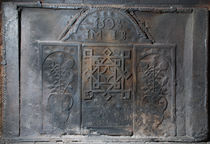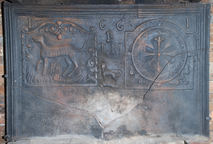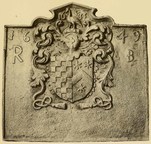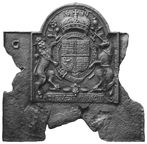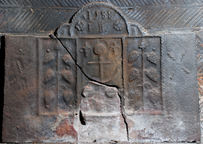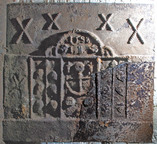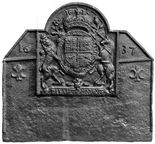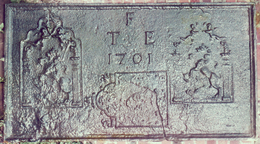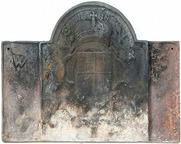-
914
Description: Rectangular shape; twisted rope edging (top and sides) with fillet edging at bottom; cast of a 1598 fireback within a recessed panel, the arch of the original fireback being overlaid with twisted rope and diagonal lengths of rope laid alongside. The original fireback is described as follows: Composite of three elements; central panel has a complex ‘knot’ pattern with a fillet edge; side panel, repeated on either side of the central panel, contains a vase of flowers, possibly stylised thistles, within an arched frame and fillet edge; arched panel above, also with fillet edge, contains the date and inscription; the spandrels of the side panels, and the arched top panel, contain a series of 'bullseye' motifs comprising concentric rings deepening towards the centre.
Notes: The central fireback measures 795mm wide by 735mm high and is from a different casting to that seen at Linchmere, Sussex (no. 475).
Inscription: 1598 / IM IB
- Decoration tags:
- rectangular (shape)
- rope (edging)
- composite
- planklines
- text
- plants
- objects
Manufactured: in the late-16th to early-17th century in the Weald area of England.
Current location: Goddards, Abinger Common, Abinger, Surrey, England.
- Attached to series:
- Armada series
- Composite firebacks
- Garden design types
-
13
Description: Rectangular; composite: complex (cavetto/cyma recta/ovolo) moulded edging (top and sides), derived from domestic carpentry; two firebacks used as patterns: on the left, rectangular with mirrored floriate scrolled top, simulated overlapping tile edging at sides, with fillet bottom edge, a mythical salamander in the form of a dog with an arrow-shaped tongue, standing among flames, a stapled scroll inside the left and right edges; on the right, arched rectangular with fillet edging indented on the inner side, surrounding a circular clock face with Roman numerals, each interspaced with a bead, and a button outside each quarter, a triangular design of swirled foliage in each bottom spandrel; initials in triad between firebacks; below, stamp formed of a talbot statant guardant upon a wreath; date split: ‘1’s in top corners, ‘6’s above initials; bottom third of fireback plain.
Notes: The talbot crest, which in this instance has been over pressed and shows the shape of the backing, is seen on other firebacks indicating a common source; the 'salamander' fireback (see no. 851) is one of the Stapled Scroll series; composite firebacks (where the impression of one or more other firebacks are used as part of the decoration) are uncommon in England but less so in France.
Inscription: 16 61 / IBM [triad]
- Decoration tags:
- rectangular (shape)
- complex, furniture-derived (edging)
- composite
- individual letters
- individual numbers
- heraldic
- mythological
- text
- animals
- objects
Manufactured: in 1661 in the Weald area of England.
Current location: in private hands, Ardingly, West Sussex, England.
- Attached to series:
- Composite firebacks
- Talbot crest series
-
831
Description: Rectangular with small detached pediment; cavetto-moulded edging; upper centre, shield, helm, crest and mantling, with date, 1635, split either side of crest; top, date, 1649, split either side of armorial; initials split either side of armorial, below date.
Notes: The armorial, tentatively associated with the family of Brooke or Broke of Madeley, Shropshire (blazon: chequy argent and sable, impaling a chevron between three estoiles), dated 1635, was formed from a pattern designed for a smaller fireback (see no. 917), but positioned on a larger backing board with the later date and initials added separately, most of the frame of the original fireback being pared away. From an illustration in the catalogue of an exhibition on heraldry at Burlington House, London, in 1894.
Inscription: 16 35 / 16 49 / R B
Arms: poss. Brooke or Broke of Staffordshire
- Decoration tags:
- rectangular with detached pediment (shape)
- cavetto (edging)
- carved stamps
- carved pattern panels
- composite
- individual letters
- individual numbers
- armorial
- text
Manufactured: in 1649 in England.
Current location: not known.
- Attached to series:
- Personal armorial firebacks
- Composite firebacks
-
224
Description: Composite; Arched rectangular shaped, armorial fireback, cavetto edging, with Stuart Royal arms, garter, supporters, crown and motto, and 1639 date above crown; this overlies a rectangular plate, with rope-effect, fillet edging; a pattern of four rosettes surrounding a fleur-de-lys, its stem terminating in a small buckle, is repeated on each side of the central armorial fireback, with the initials above; each rosette is stamped separately.
Notes: The armorial may originally have been one of the 1619 series. Formerly at Wonastow Court, Momouthshire
Inscription: 1639 / G / HONI SOIT QVI MAL Y PENSE / DIEV ET MO DROIT
Arms: English Stuart royal
- Decoration tags:
- rectangular with round arch (shape)
- fillet (edging)
- whole carved pattern
- composite
- individual letters
- armorial
- text
Manufactured: in 1639 possibly in the Forest of Dean area of England.
Current location: National History Museum, St Fagans, Glamorgan, Wales.
Museum number: 40.428 (part of the Welsh National History Museum museum group)
-
247
Description: A modified recasting of a variant of the ‘Armada’ fireback, with initials changed to IK, a single anchor panel, and the addition of a plain base and borders, the latter each with a twisted rope saltire, upper middle.
Notes: It is likely that an original four-panel fireback has been used to recast a copy with additional side and base panels; the saltires may have apotropaic significance. A second fireback at the house cast in the 19th century is identical but for being 1% smaller all round, and has a full-width extension on top bearing four symmetrical rope saltires, the outer two larger than the inner two. The first example was used to make the second.
Inscription: 1588 / IK
- Decoration tags:
- rectangular with round arch (shape)
- simulated rope (edging)
- simple stamps
- carved pattern panels
- composite
- extension panels
- apotropaic
- text
- plants
- objects
Manufactured: in the 17th century in the Weald area of England.
Current location: Chawton House, Chawton, Hampshire, England.
- Attached to series:
- Armada series
-
1148
Description: A composite recasting placing, on a plain background with symmetrical rope saltires, a recast variant of the ‘Armada’ fireback, with changed initials, a single anchor panel, and the addition of plain base and borders, the latter each with a twisted rope saltire, upper middle.
Notes: It is likely that an original four-panel fireback was used to cast an early copy with additional side and base panels. In the 19th century this second fireback was used to cast this third fireback with an additional full-width extension on top bearing four symmetrical rope saltires, the outer two larger than the inner two. The image of this fireback has been reconstructed by computer, combining photographs of the two fragments into which it had been broken.
Inscription: 1588 / IK
- Decoration tags:
- rectangular (shape)
- none (edging)
- simple stamps
- carved pattern panels
- composite
- apotropaic
- text
- plants
- objects
Manufactured: in the early- to mid-19th century in England.
Current location: Chawton House, Chawton, Hampshire, England.
- Attached to series:
- Armada series
- Composite firebacks
-
955
Description: Composite; canted arched rectangular shape; armorial fireback, cavetto edging, with Stuart Royal arms, garter, supporters, crown and motto, and 1620 date above crown; this overlies a canted rectangular plate, with twisted rope edging, fillet; two quasi-horizontal fillets from the tops of the vertical sides to the middle of the armorial fireback separate the back into two uneven parts, the date in the top part, split by the armorial, and a fleur-de-lys at the top of the lower part, also separated by the armorial.
Notes: The use of the armorial back is seen frequently and probably dates from 1619, though the date is usually altered; in this case the alteration does not match the more prominent date for the fireback; photograph ex T. Crowther & Son Ltd, 1985.
Inscription: 16 29 / HONI SOIT QUI MAL Y PENSE / 16 37 / DIEV ET MON DROIT
Arms: English Stuart royal
- Decoration tags:
- rectangular with canted top corners and round arch (shape)
- rope (edging)
- carved stamps
- whole carved pattern
- composite
- individual numbers
- heraldic
- armorial
- royal
- text
Manufactured: in 1637 possibly in the Forest of Dean area of England.
Current location: not known.
-
1011
Description: Rectangular shape with cavetto-moulded edging; top centre, initials in triad with date below; on each side, stamp formed of a small, wavy-arched rectangular fireback bearing a lion rampant between pilasters surmounted by burning cauldrons, beneath two mirrored putti holding branches; beneath the date, a stamp formed of a small arched-rectangular fireback laid on its left side with a burning cauldron on each shoulder and the faint figure of a bird in the centre.
Notes: The two identical fireback stamps on either side of the inscription have been noted elsewhere (see no. 210 Late Pictorial series 5); the centre and right fireback stamps have been impressed insufficiently; illustration from Country Life advertisement by T. Crowther & Son Ltd, 18 Oct 1984.
Inscription: TFE [triad] / 1701
- Decoration tags:
- rectangular (shape)
- cavetto (edging)
- composite
- individual letters
- individual numbers
- pictorial
- architectural
- text
- animals
Manufactured: in 1701 in England.
Current location: not known.
- Attached to series:
- Composite firebacks
- Late pictorial series (all)
- Late pictorial series 5
-
1281
Description: Composite; arched rectangular shaped, armorial fireback, cavetto edging, with Stuart Royal arms, garter, supporters, crown and motto, and 1639 date above crown; this overlies a rectangular plate with fillet edging; top centre in the space each side of the central shield, an initial letter - W to left, C to right.
Notes: One of several variants using a fireback with the English Stuart royal arms, the date probably altered according to when it was cast. The original date of the fireback was probably 1619. Garth's Auctioneers, Columbus, OH, 3 Jan 2015, lot 2347 ($300).
Inscription: 1639 / W C
Arms: English Stuart royal
- Decoration tags:
- rectangular with round arch (shape)
- fillet (edging)
- carved stamps
- whole carved pattern
- composite
- extension panels
- heraldic
- armorial
- royal
- text
Manufactured: in 1639 possibly in the Forest of Dean area of England.
Current location: not known.
-
108
Description: Quasi-rectangular with narrow arches at top ends and a broad low central arch, between which are flat-topped peaks linked to the arches by shallow concave curves; flanged edge (top and sides); mirroring the edge a channel has been engraved into the metal, extending into the small arches, producing the effect of a wide fillet along the top and sides with an inverted U-shaped return into the end arches; within the channel, at each end, a primitive representation of a vertical, hollow plant stem and four mirrored pairs of curved branches, with a vertical channel parallel to the edge joining the branch ends on the inside; between these is cast a small, rectangular panel with ovolo edging, bearing a full achievement of the arms of the Worshipful Company of Clothworkers; the date is centrally placed above this panel.
Notes: An usual fireback for several reasons: the use of engraving for significant elements of the design, the flanged edge, and the incorporation of a small fireback. The Clothworkers’ arms: Sable a chevron ermine between in chief two Havettes Argent and in base a Teazel Cob Or; crest: on a Mount vert a Ram statant Or; supporters: two Griffins Or pellettée; the arms as displayed were granted in 1587. An example of the armorial fireback on its own is in Petworth House (no. 522).
Inscription: WV 1659 WV
Arms: Worshipful Company of Clothworkers
- Decoration tags:
- rectangular with three arches (shape)
- flanged (edging)
- composite
- individual numbers
- planklines
- armorial
- text
Manufactured: in 1659 in the Weald area of England.
Current location: Haslemere Educational Museum, Haslemere, Surrey, England.
Museum number: 8587 (part of the Haslemere Educational Museum museum group)
- Attached to series:
- Composite firebacks
- Livery company firebacks
